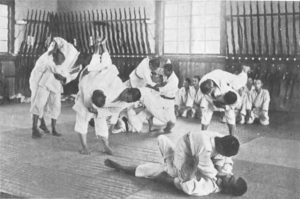choque, Vol. 2
Nrog choque, Vol. 2 (Amazon affiliate txuas), Roberto Pedreira picks txog zaj dabneeg ntawm Brazilian Jiu-Jitsu nyob li cas nws considers nws heyday hauv Brazil, 1950 – 1960. Besides Carlos thiab Helio Gracie, ob peb lwm academies, Xws li Oswaldo Fadda tus, Kuj thriving. Judo yog nkag mus rau tej chaw tab sis twb tsis overcome Jiu-Jitsu nyob rau tej chaw.
Vale Tudo matches were at the height of their popularity and regularly televised. Gracie Academy students were featured on television with other grapplers and professional wrestlers in competitive grappling contests.

Jujitsu siv ntawm Japanese Agricultural kawm ntawv nyob rau hauv 1922
Helio Gracie took part in the most important matches of his professional fighting career in his late 30s and early 40s. Helio drew with and defeated Kato. He lost to Kimura and Waldemar Santana. Despite the losses, Helio fought well for his age and emerged with a stronger reputation than when he entered the contests.
Txawm li cas los, the most significant development in the spread of Brazilian Jiu-Jitsu was the emergence of the second generation of Gracies, Carlson and Robson Gracie, plus their close friend Joao Alberto Barreto. Throughout the 1950s, these three men defended the reputation of the academy against all challenges. While Carlson was considered the family champion after avenging his uncle’s loss to Santana, Robson fought many challenge matches during this time. It was only Robson’s small size, which prevented him from answering all the challenges made to the academy.
While Pedreira still shares his rather low opinion of Carlos and Helio Gracie, he obviously respected the younger Gracies. While he does change his opinion of one of the second generation in the last volume of choque, he writes well of them in this volume. Fans of BJJ history should read this volume to learn more about Robson and Joao Alberto Barreto alone.
choque, Ntim 2 is more readable at half the length of Ntim 1. Ntim 2 yog 443 pages. While a more developed narrative style would help the reading experience, this book is a must read for those interested in Brazilian Jiu-Jitsu history not told from a Gracie perspective.
Koj yuav tawm ib saib los nug cov lus nug txog qhov no los yog tej tsev xa rau kuv Facebook phab.
PIN rau nws
